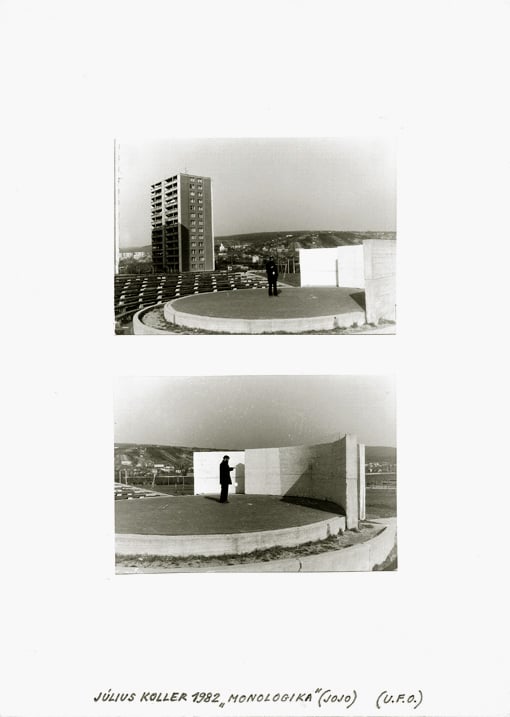
© » KADIST
Julius Koller
The photograph Monologic – Yo-Yo 1, 2 (U. F. O. ), (1982), shows Koller playing with a big white Yo-Yo in a drab concrete building among a group of tower blocks.

© » KADIST
Julius Koller
Drawing & Print (Drawing & Print)
Anti-Happening refers to Koller’s 1965 manifesto, ‘Anti-Happening (System of Subjective Objectivity)’. In opposition to the notion of a ‘happening’ as a way of actualising group identity, in his manifesto, Koller stated that his concept of the ‘anti-happening’ aimed at a ‘cultural reshaping of the subject, at awareness, at the surroundings and the real world’ [i] . Unlike happenings, these actions do not involve the staging of psychologically expressive performances.

© » KADIST
Julius Koller
Wordplay was a central focus of Koller’s work, in particular the acronym U. F. O, which he adapted in his diagrammatic drawings to stand variously for Univerzálna Futurologická Organizácia (Universal Futurological Organization, 1972–3), Univerzálny Filozoficky Ornament (Universal Philosophical Ornament, 1978) or Underground Fantastic Organization (1975), and which also appeared in a series of slapsticky self-portraits titled ‘U. F. O.–naut’ (1970–2007). These infinite variations on a common cipher constituted an insistent incantation of the Utopian principle.
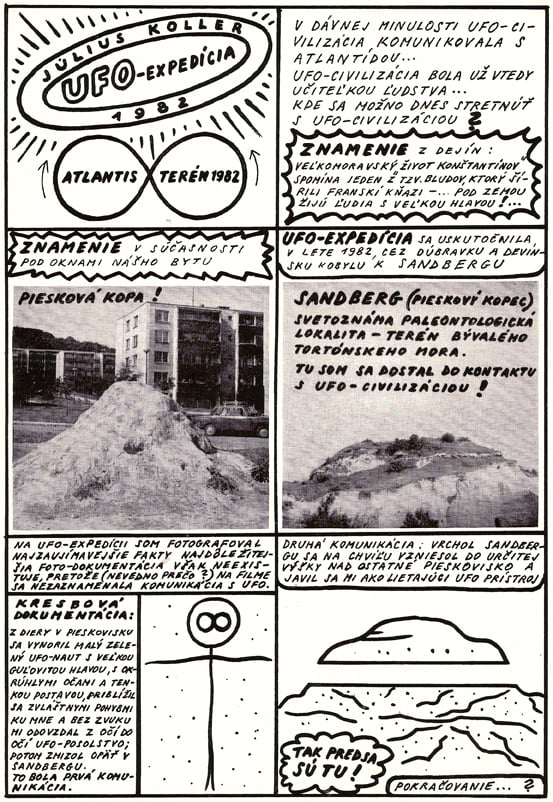
© » KADIST
Julius Koller
Drawing & Print (Drawing & Print)
Wordplay was a central focus of Koller’s work, in particular the acronym U. F. O., which he adapted in his diagrammatic drawings to stand variously for Univerzálna Futurologická Organizácia (Universal Futurological Organization, 1972–3), Univerzálny Filozoficky Ornament (Universal Philosophical Ornament, 1978) or Underground Fantastic Organization (1975), and which also appeared in a series of slapsticky self-portraits titled ‘U. F. O.–naut’ (1970–2007). These infinite variations on a common cipher constituted an insistent incantation of the Utopian principle.
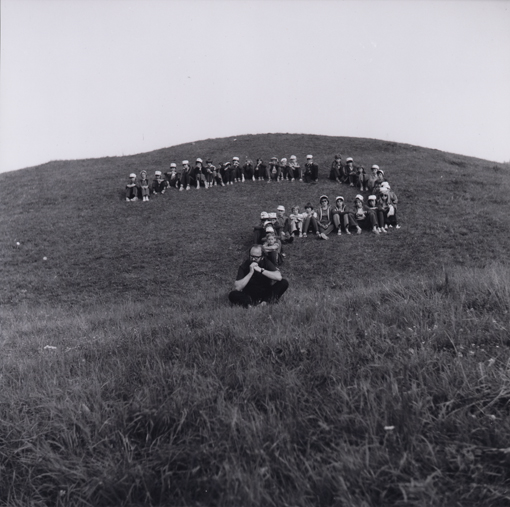
© » KADIST
Julius Koller
This work is one of Koller’s many variations which he began to use from 1970 to describe the ‘cultural situations’ he created. His “Anti-Happenings” turned mundane events into ‘cultural’ and ‘subjective’ situations. He sought to create new cultural situations that weren’t new art, but rather new ways of living: a new creativity for a new humanistic culture.

© » KADIST
Roman Ondak
This work needs to be considered in relation to one of his performances during which people were made to queue in front of the Kunsthalle of Frankfurt in 2003 (Tate Collection). In this instance Ondak collected images of people queuing in front of all sorts of buildings in various newspapers. He then inserted these in a Slovakian newspaper without trying to give any coherence with the information in the text on the same page.

© » KADIST
Roman Ondak
Drawing & Print (Drawing & Print)
As the caption purposely admits, these drawings were made by friends of Ondák’s at home in Slovakia asked to interpret places he has journeyed to. The description of the blond artist wearing the same outfit and bag in places of transit like airports, stations or streets are faithful in straightforward (verging on naïve) styles. His own skill as artist is displaced and delegated to others with no particular gift in draftsmanship.
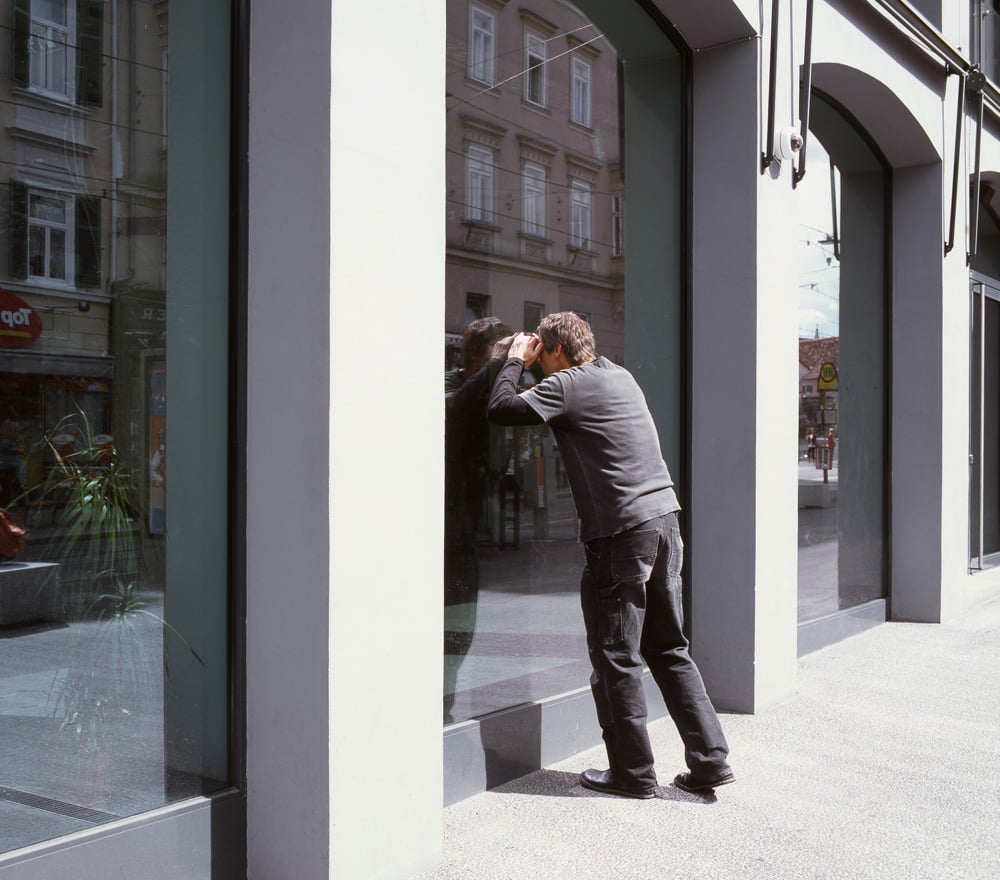
© » KADIST
Roman Ondak
“A man wanders near the windows of a gallery, situated adjacent to the street. He occasionally gazes through windows into the gallery but never enters.” Passersby are numerous since these windows are by a tram stop on a busy street. It is surprising to note how few of them take any notice of this man peering repeatedly through the slightly tinted glass into an empty meeting room with no distinctive signs to be seen.
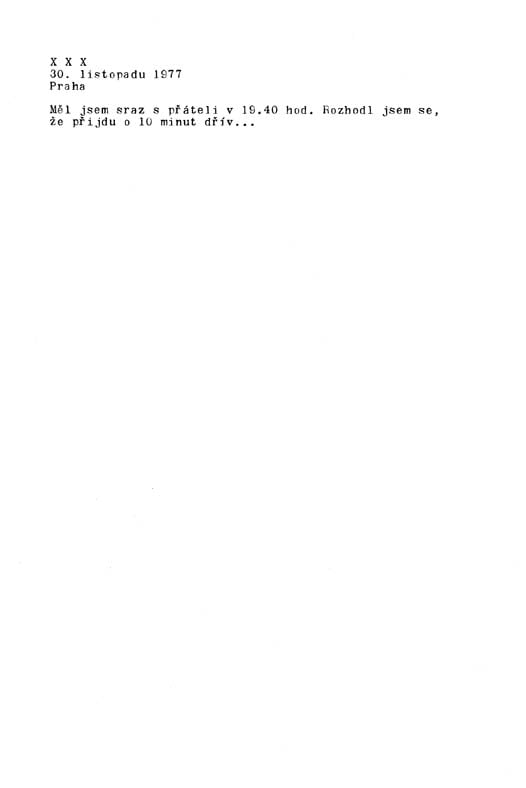
© » KADIST
Jiri Kovanda
Drawing & Print (Drawing & Print)
All Kovanda’s artistic practice poses the question of visibility. Having worked on actions and performance, the artist decided to ‘disappear’ from his artworks during twenty years; in 2007, his performance Kissing through glass in the institutional setting of Tate Modern was acclaimed by critics. Some works are only visible thirty years later via traces and archives; the artist’s rehabilitation by institutions and galleries offers a new critical reading of his practice which had until then remained rather confidential.
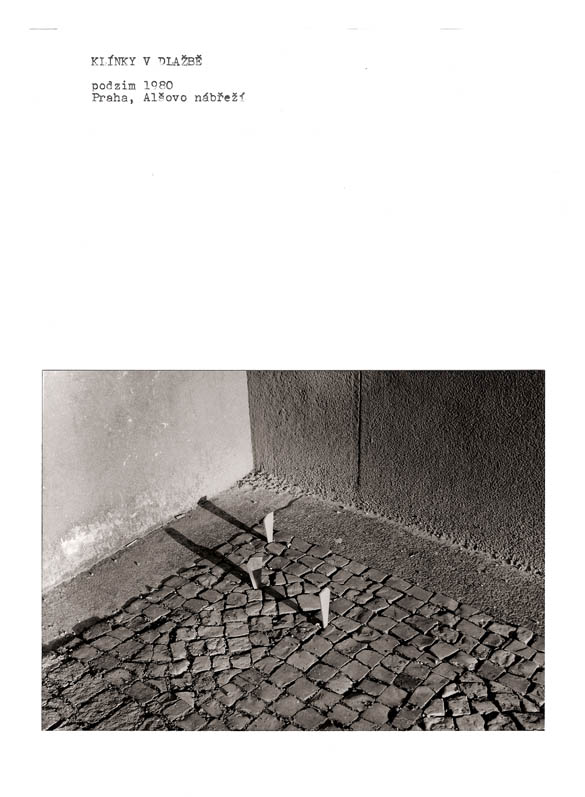
© » KADIST
Jiri Kovanda
Kovanda’s street interventions are always documented according to the same format as the actions: a piece of A4 paper, a typewritten text giving a precise location and date, and a photograph. Contrarily to the actions, he took the photographs himself. One of the rules he stuck to in his artistic practice was to always use material at his disposal, a real economy of means.
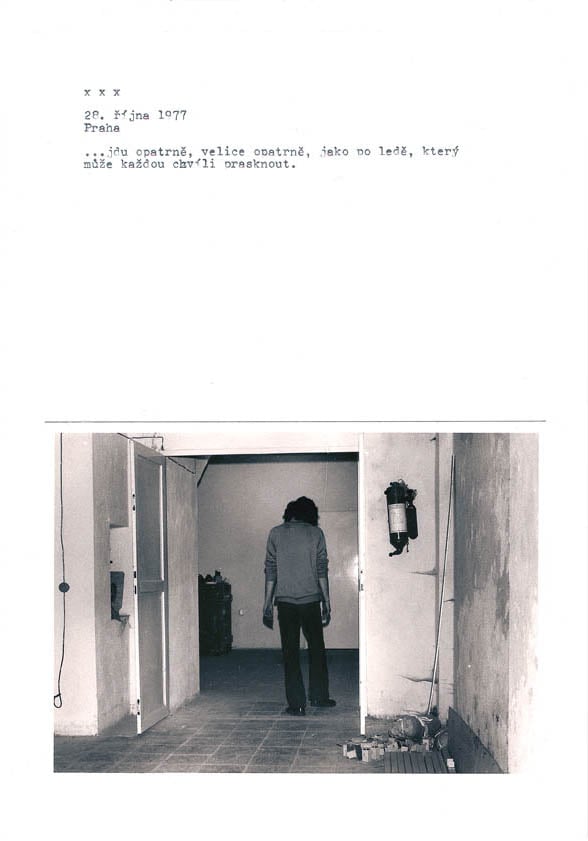
© » KADIST
Jiri Kovanda
Kovanda’s ‘discreet’ actions (leaving a discussion in a rush, bumping into passers-by in the street, making a pile of rubbish and scattering it, looking at the sun until tears come…) are always documented according to the same format: a piece of A4 paper, a concise typewritten text, and sometimes a photograph taken by someone else. This action, walking abnormally slowly, questions the place of the individual within the space of a city with regards to social habits. Kovanda places himself slightly outside the regulated rhythm of the city walking.

© » KADIST
Jiri Kovanda
This ephemeral installation by Jirí Kovanda, documented in the same way as his performances with a photograph and a text, belongs to a body of works that took place in his apartment/studio. During an interview with Hans Ulrich Obrist, the artist highlighted that he had never had a studio and that this work space blended with his apartment. A piece of string cuts across the room in a diagonal; it functions as a scale to measure time and space.
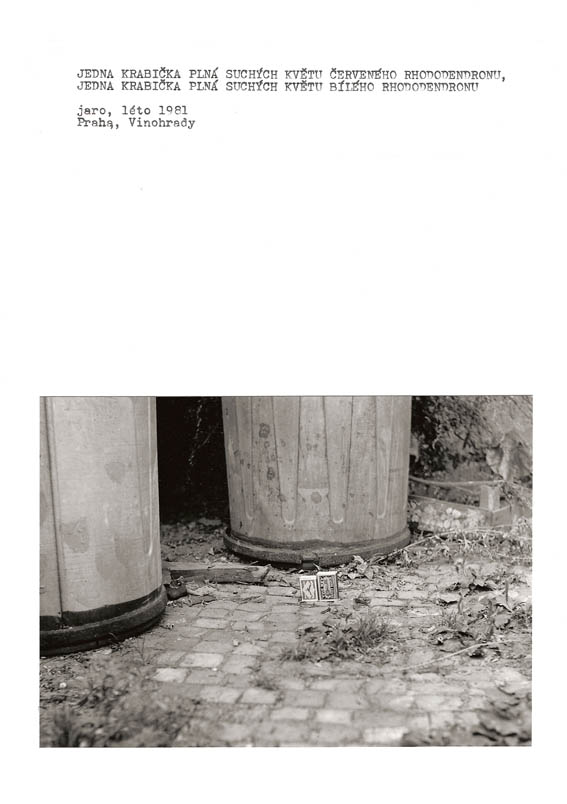
© » KADIST
Jiri Kovanda
Kovanda’s street interventions are always documented according to the same format as the actions: a piece of A4 paper, a typewritten text giving a precise location and date, and a photograph. Contrarily to the actions, he took the photographs himself. One of the rules he stuck to in his artistic practice was to always use material at his disposal, a real economy of means.

© » KADIST
Jiri Kovanda
Kovanda’s street interventions are always documented according to the same format as the actions: a piece of A4 paper, a typewritten text giving a precise location and date, and a photograph. Contrarily to the actions, he took the photographs himself. One of the rules he stuck to in his artistic practice was to always use material at his disposal, a real economy of means.

© » KADIST
Jiri Kovanda
Untitled (1992) responds to the same principles of an economy of means as the artist’s actions and installations: three empty cardboard boxes which have contained photographic film are piled one on top of the other. Nevertheless there is a harmony in the assembly of forms, writing, colors, proportions; an aesthetic construction is carried by this contemporary still life. This work charts the passing of time: the cardboard yellows, the film becomes obsolete in the digital age.
Jiri Kovanda
- location: Praha, Ceská Republika
- year born: 1953
- gender: male
- nationality: Czech
Julius Koller
- location: Pieštany, Slovenská Republika
- year born: 1939
- gender: male
- nationality: Slovakian
Roman Ondak
- location: Zilina, Slovenská Republika
- year born: 1966
- gender: male
- nationality: Slovakian
-
-
1970-1979
Jiri Kovanda
Drawing & Print
1977(Drawing & Print) All Kovanda’s artistic practice poses the question of visibility...
Julius Koller
1978This work is one of Koller’s many variations which he began to use from 1970 to describe the ‘cultural situations’ he created...
Jiri Kovanda
1979This ephemeral installation by Jirí Kovanda, documented in the same way as his performances with a photograph and a text, belongs to a body of works that took place in his apartment/studio...
-
1980-1989
Jiri Kovanda
1980Kovanda’s street interventions are always documented according to the same format as the actions: a piece of A4 paper, a typewritten text giving a precise location and date, and a photograph...
Jiri Kovanda
1980Kovanda’s street interventions are always documented according to the same format as the actions: a piece of A4 paper, a typewritten text giving a precise location and date, and a photograph...
Jiri Kovanda
1980Kovanda’s street interventions are always documented according to the same format as the actions: a piece of A4 paper, a typewritten text giving a precise location and date, and a photograph...
Julius Koller
Drawing & Print
1982(Drawing & Print) Wordplay was a central focus of Koller’s work, in particular the acronym U...
-
1990-1999
Jiri Kovanda
1992Untitled (1992) responds to the same principles of an economy of means as the artist’s actions and installations: three empty cardboard boxes which have contained photographic film are piled one on top of the other...
-
2000-2009
Roman Ondak
2003This work needs to be considered in relation to one of his performances during which people were made to queue in front of the Kunsthalle of Frankfurt in 2003 (Tate Collection)...
Roman Ondak
Drawing & Print
2003(Drawing & Print) As the caption purposely admits, these drawings were made by friends of Ondák’s at home in Slovakia asked to interpret places he has journeyed to...
